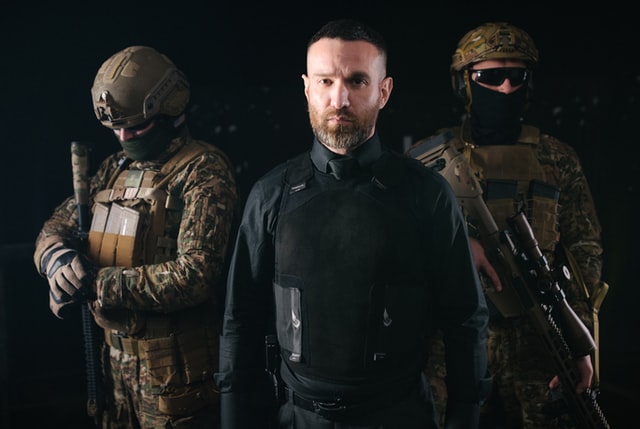With the integration of Elbit Systems London into the British Military of Defence, the UK recruits could soon see action with some shiny new toys. These are no mere guns either. As an extra defensive measure, they are incorporated with AI to feed the sniper information about the situation.
It got us wondering what other defensive gadgets are out on the battlefield, or perhaps being developed to join new recruits. We’re taking a look at the most advanced defensive gadgets in the military.
BodyGuard Electro Gauntlet
The BodyGuard Electro Gauntlet looks like something out of Batman. It is a piece of equipment worn on the forearm and made from hardened plastic. Its initial purpose is to put some power behind your blocking, so that an attack coming at you is better avoided, but it is stuffed with gadgets that will help out in a pinch.
Not least of these gadgets are the two little spikes atop the wrist that act as a taser! Press a button on the palm of the gauntlet and you will send a non-lethal electric volt through your opponent. There are lasers, video recording and transmission, biometric readers and more in this gadget. Plus, the gauntlet has a heart rate monitor that will alert someone if it senses distress and GPS so that you can be found.
Xstat
The biggest killer on the battlefield is blood loss. And unfortunately, there is no pill to solve that. There are tourniquets, but they are hard to apply yourself if you get hit in the wrong place and they are not effective for blood loss coming from the armpits or groin. Plus, if you’re a medic treating a wound, you’re going to want to put pressure on the wound, which leaves you without hands to deal with anything else.
This is where the Xstat comes in. It offers a simpler means of applying a tourniquet and will work anywhere. They are injectable sponges. You’ll get an injector syringe, which is smaller than the tourniquet for long treks, filled with pill-sized sponges dipped in a hemostatic agent. Inject and the sponges will expand with the blood and put pressure on the wound, stopping blood loss in less than fifteen seconds.
Liquid armour
We’ve used Kevlar and other materials incorporated into our police and soldiers’ vests to keep them bulletproof from enemy fire since before the First World War, but there’s a new material on the market, and it is commonly called liquid armour.
Currently under research by MIT and the United States Army Research Laboratory, the liquid armour idea comes from the well-known synthetic fibre Kevlar soaked in a thickening fluid. This fluid will allow the impact of a bullet hitting it to spread, so that it’s more akin to a beanbag bullet. The power will spread across the surface area rather than pierce the fibre and therefore the body behind it. It’s sure to still hurt, but the damage won’t be as bad, in fact it could be relatively a lot better.
This article does not necessarily reflect the opinions of the editors or management of EconoTimes



 Nvidia Develops New Location-Verification Technology for AI Chips
Nvidia Develops New Location-Verification Technology for AI Chips  Air Transat Reaches Tentative Agreement With Pilots, Avoids Strike and Restores Normal Operations
Air Transat Reaches Tentative Agreement With Pilots, Avoids Strike and Restores Normal Operations  JD.com Pledges 22 Billion Yuan Housing Support for Couriers as China’s Instant Retail Competition Heats Up
JD.com Pledges 22 Billion Yuan Housing Support for Couriers as China’s Instant Retail Competition Heats Up  Intel’s Testing of China-Linked Chipmaking Tools Raises U.S. National Security Concerns
Intel’s Testing of China-Linked Chipmaking Tools Raises U.S. National Security Concerns  Azul Airlines Wins Court Approval for $2 Billion Debt Restructuring and New Capital Raise
Azul Airlines Wins Court Approval for $2 Billion Debt Restructuring and New Capital Raise  ANZ Faces Legal Battle as Former CEO Shayne Elliott Sues Over A$13.5 Million Bonus Dispute
ANZ Faces Legal Battle as Former CEO Shayne Elliott Sues Over A$13.5 Million Bonus Dispute  Moore Threads Stock Slides After Risk Warning Despite 600% Surge Since IPO
Moore Threads Stock Slides After Risk Warning Despite 600% Surge Since IPO  EssilorLuxottica Bets on AI-Powered Smart Glasses as Competition Intensifies
EssilorLuxottica Bets on AI-Powered Smart Glasses as Competition Intensifies  GameStop Misses Q3 Revenue Estimates as Digital Shift Pressures Growth
GameStop Misses Q3 Revenue Estimates as Digital Shift Pressures Growth  Samsung SDI Secures Major LFP Battery Supply Deal in the U.S.
Samsung SDI Secures Major LFP Battery Supply Deal in the U.S.  China Adds Domestic AI Chips to Government Procurement List as U.S. Considers Easing Nvidia Export Curbs
China Adds Domestic AI Chips to Government Procurement List as U.S. Considers Easing Nvidia Export Curbs  Rio Tinto Signs Interim Agreement With Yinhawangka Aboriginal Group Over Pilbara Mining Operations
Rio Tinto Signs Interim Agreement With Yinhawangka Aboriginal Group Over Pilbara Mining Operations  EU Court Cuts Intel Antitrust Fine to €237 Million Amid Long-Running AMD Dispute
EU Court Cuts Intel Antitrust Fine to €237 Million Amid Long-Running AMD Dispute  Apple App Store Injunction Largely Upheld as Appeals Court Rules on Epic Games Case
Apple App Store Injunction Largely Upheld as Appeals Court Rules on Epic Games Case  Mizuho Raises Broadcom Price Target to $450 on Surging AI Chip Demand
Mizuho Raises Broadcom Price Target to $450 on Surging AI Chip Demand  SK Hynix Considers U.S. ADR Listing to Boost Shareholder Value Amid Rising AI Chip Demand
SK Hynix Considers U.S. ADR Listing to Boost Shareholder Value Amid Rising AI Chip Demand  Trump’s Approval of AI Chip Sales to China Triggers Bipartisan National Security Concerns
Trump’s Approval of AI Chip Sales to China Triggers Bipartisan National Security Concerns 































